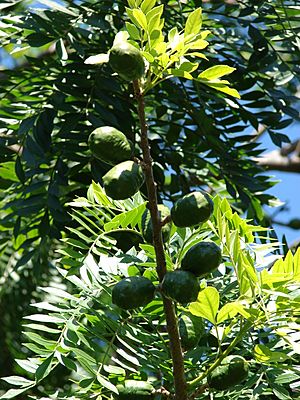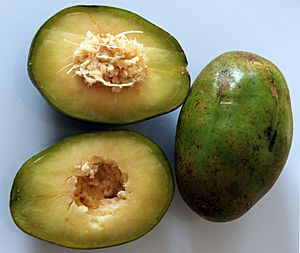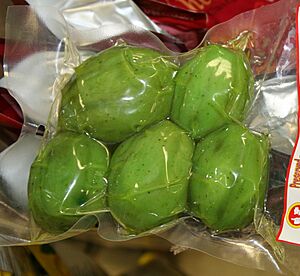Spondias facts for kids
Quick facts for kids Spondias |
|
|---|---|
 |
|
| Fruiting Spondias mombin | |
| Scientific classification |
|
| Kingdom: | Plantae |
| Clade: | Tracheophytes |
| Clade: | Angiosperms |
| Clade: | Eudicots |
| Clade: | Rosids |
| Order: | Sapindales |
| Family: | Anacardiaceae |
| Subfamily: | Spondiadoideae |
| Genus: | Spondias L. |
| Type species | |
| Spondias mombin |
|
| Species | |
| Synonyms | |
|
Allospondias (Pierre) Stapf |
|
Spondias is a group of flowering plants. They belong to the cashew family, called Anacardiaceae. There are 17 known types, or species, of Spondias. Seven of these species grow naturally in the Americas, and about 10 grow in tropical Asia.
These plants are often called hog plums or Spanish plums. Sometimes, they are even called golden apples because their bright fruits look a bit like small apples or plums. However, they are not closely related to real apple or plum trees. A clearer common name for them is mombins.
The city of Bangkok in Thailand might have gotten its name from Spondias dulcis. In Thai, this fruit is called makok nam, which means 'water olive'. In Cambodia, Spondias pinnata is known as /pɷːn siː pʰlaɛ/ or /məkaʔ prẹj/. Spondias dulcis is simply called /məkaʔ/. In the Tamil language, Spondias pinnata is called Pulicha kaai, meaning "sour fruit." It is also known as Amate Kaai in Kannada, Ambade in Tulu and Konkani. In Sri Lanka, it's called Amberella. In Bangladesh, it is known as Aamra (আমড়া). When served with spices, it is a very popular street food.
What Spondias Plants Look Like
Spondias plants are trees that can grow up to 25 meters (about 82 feet) tall. They can be deciduous, meaning they lose their leaves every year, or semi-evergreen, meaning they keep some leaves all year.
Their leaves grow in a spiral pattern. They are usually pinnate, which means they have leaflets arranged along a central stem, like a feather. Sometimes, they can be bipinnate or even simple.
The fruit of a Spondias plant is a drupe. This is a type of fruit with a fleshy outer part and a hard shell inside that contains a single seed. It looks similar to a small mango. The fruits are 4–10 centimeters (about 1.5–4 inches) long. They ripen to a yellow or orange color.
Spondias as Food
About 10 different types of Spondias plants produce fruits that people can eat. Some of these have been grown by humans for their fruit. Animals like deer also enjoy eating these fruits.
In the Western Ghats region of Karnataka, India, the flower buds and young fruits are used to make pickles. In Thai cuisine, both the fruits and the soft, young leaves are eaten. In Odisha, India, the fruit is called ambada. It is used to add a sour taste to curries.
Types of Spondias Plants
As of July 2020, there are 19 accepted species of Spondias. Here are some of them:
- Spondias acida
- Spondias admirabilis
- Spondias bahiensis
- Spondias bipinnata
- Spondias dulcis — also known as Tahitian apple
- Spondias expeditionaria
- Spondias globosa
- Spondias macrocarpa
- Spondias malayana
- Spondias mombin — also known as Yellow mombin or gully plum
- Spondias novoguineensis
- Spondias pinnata
- Spondias purpurea — also known as Jocote or purple mombin
- Spondias radlkoferi
- Spondias tefyi
- Spondias testudinis
- Spondias tuberosa — also known as Umbú or Brazil plum
- Spondias venulosa
- Spondias xerophila
Some names that were once used for Spondias are now considered synonyms (other names for the same plant or a different plant):
- Spondias cytherea — this is another name for Spondias dulcis
- Spondias haplophylla — this is now known as Bouea oppositifolia
- Spondias indica — this is now known as Solenocarpus indicus
- Spondias lakonensis — this is now known as Allospondias lakonensis
See also
 In Spanish: Spondias para niños
In Spanish: Spondias para niños



